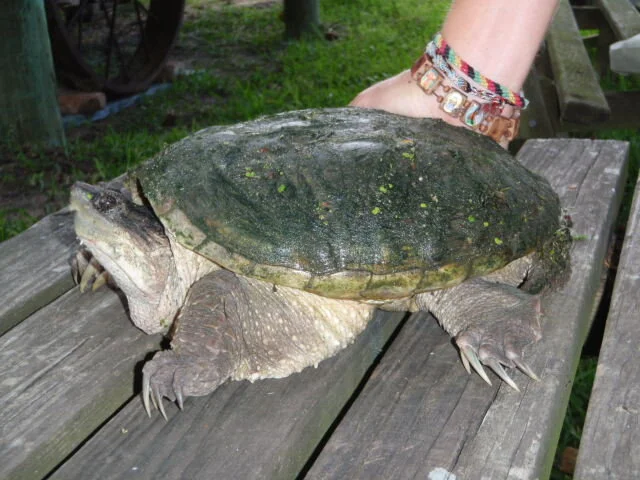Texas Turtles
Basking Red Eared Slider | Photo by Gary Seloff
~Written by Mark Kramer
I grew up with a pet turtle, as did many of my friends in the 1960’s. Turtles were commonly sold in “dollar stores” as a novelty and they came with their own handy plastic container. We kept mine on the kitchen sink. The sale of hatchling red-eared sliders continued for a handful of years until it was recognized that they may also carry salmonella.
Egg Laying Red Eared Slider | Photo by Lyman Brown
Turtles still carry a fascination for most people and seem like they’re on the perfect vacation lifestyle. Their RV is on their back, dinner is fish which is always eaten slowly and enjoyed one bite at a time. They finish the day alternating between swim breaks and sunbathing. For many who visit Armand Bayou Nature Center, the first encounter with wildlife is on the entry boardwalk. Turtles commonly sighted basking on the shoreline are the delight of many visiting school children on their way to explore the depths of the nature center.
Armand Bayou is ideal habitat for these leisure loving pleasure-seekers which spend most of their life in the water. This time of year, there is an exception to their semi-aquatic water loving ways and it can be deadly for them. As with all reptiles, turtles deposit their eggs on dry land. That’s where the Spring turtle odyssey begins. Gravid females leave the safety of their aquatic habitat and travel some distance from the water’s edge in search of the ideal location to safely deposit this year’s clutch of eggs. Some turtles only move a few feet from the water’s edge, but others decide to walk hundreds of yards before laying their eggs. That journey can be perilous in the most densely populated county in Texas.
This is the time when we see Houston’s most common turtles (red-eared slider, common snapping turtle, spiny soft-shell turtle) in unexpected locations. You may have seen them crossing the road or walking across the ABNC Parking lot. Please drive slowly as they won’t get out of your way. Every year we have the privilege to observe this spectacle and witness the egg-laying marvel.
Spiny Soft-Shelled Turtle | Photo by Kelli Ondracek
Common Snapping Turtle | Photo by Kelli Ondracek
In the recent past, ABNC also participated in a research study that is worth reflecting on today. Texas wildlife regulatory agencies had growing concerns about the trapping and sale of turtles. The above-mentioned species were being targeted by commercial trappers and sold for meat to the emerging middle class of Chinese consumers. Texas turtles were captured, transported alive, and then sold in the “wet markets” that are now familiar to Americans through the Covid-19 Pandemic. Between 2002 and 2005 more than 250,000 wild-caught turtles were shipped from the Dallas airport alone! For three summers, ABNC Staff captured, tagged, and released turtles, providing data to better guide policy. Turtles are generally slow to reach sexual maturity. When large numbers of breeding age adults are removed from waterways, turtle populations crash and can take decades to recover. We also now know the consequences of selling wildlife in these open-air live wildlife meat markets. All things considered, it’s worth reconsidering before putting turtles on the menu.
For a deeper dive into more Texas turtles check out this video, Bayou City Eco-Almanac: Bringing Back Coastal Turtles




